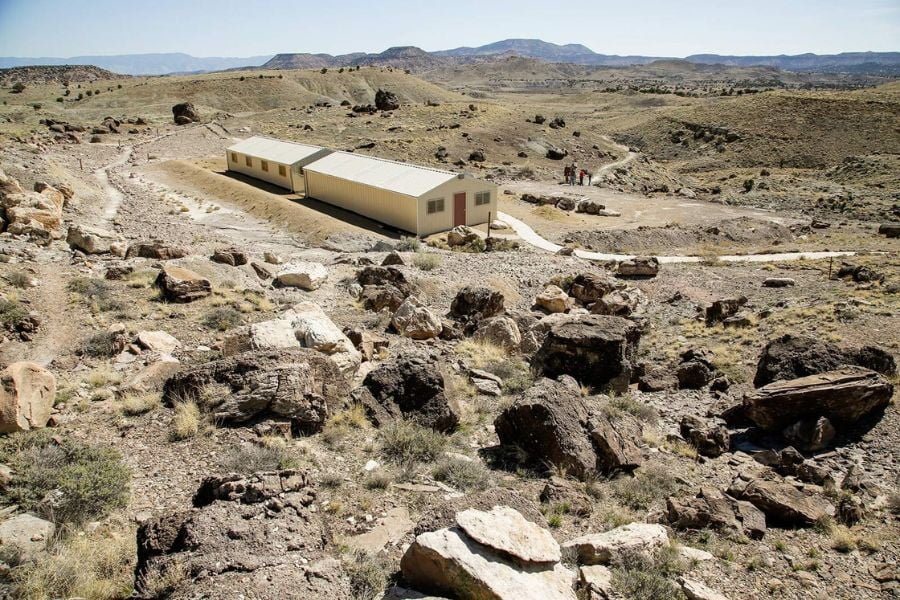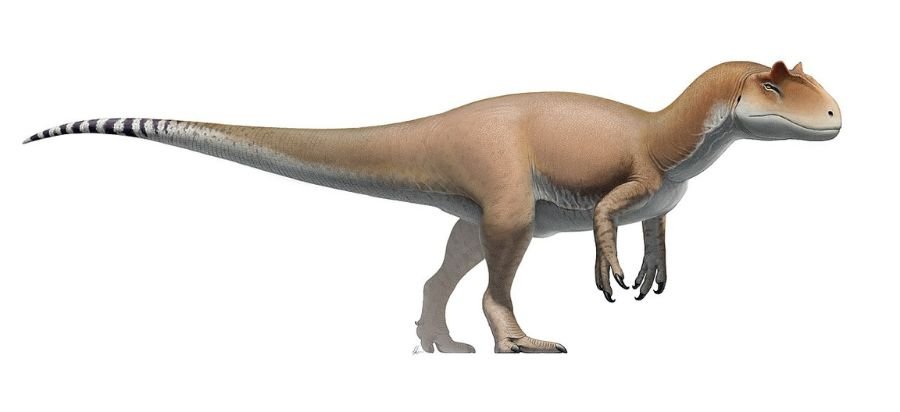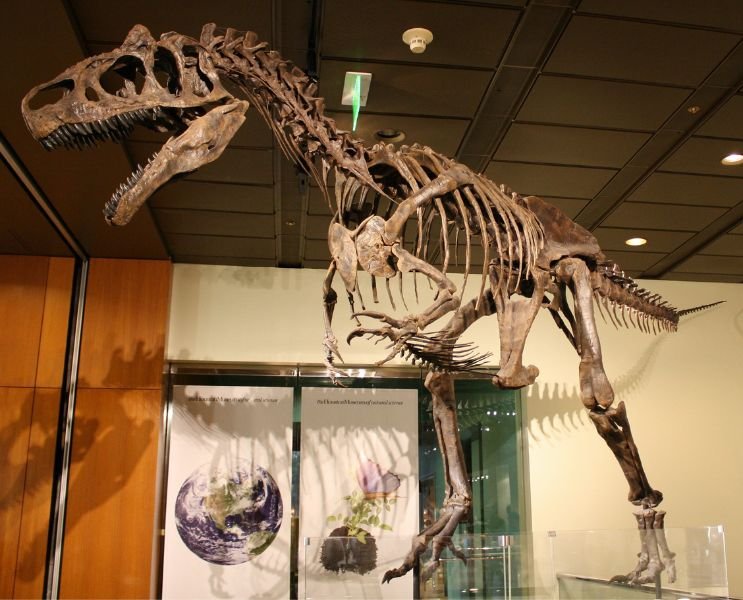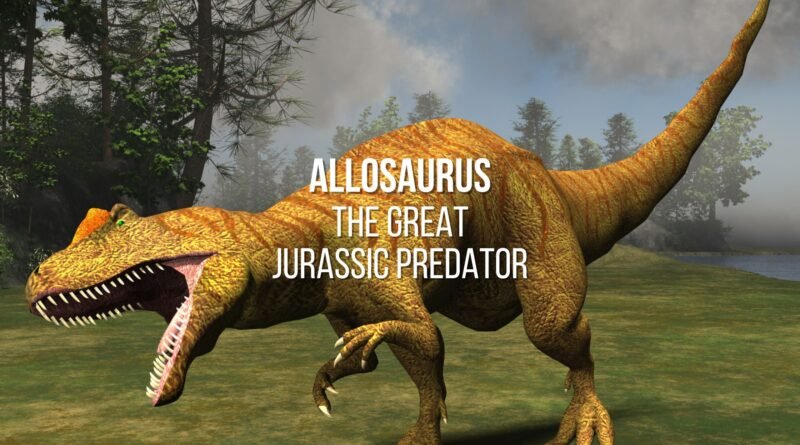Allosaurus: The Great Jurassic Predator
Almost always when we think of a type of fierce and frightening dinosaur, we think of Tyrannosaurus Rex, right? However, there is another dinosaur, but this time representing the Jurassic Period, which was just as, or perhaps even more ferocious and frightening than T-Rex: the Allosaurus Fragilis. Have you ever heard of it? In this article, we have tried to gather all the information about this large predator, its features, behavior, and much more. Come with us to travel back in time and discover the reign of this fearsome hunter from Jurassic times. Have fun with reading!
Allosaurus: The Jurassic Monster
Allosaurus is a genus of large theropod dinosaur that roamed the Earth during the Late Jurassic period, approximately 155-145 million years ago. It was one of the largest and most prevalent predators of its time. Allosaurus fossils have provided paleontologists with valuable insights into the world of dinosaurs.
This impressive creature boasted a massive head with sharp teeth in its beak, short arms equipped with two large claws, and powerful legs featuring three toes on each foot. Its body was covered in thick, armor-like skin. Despite its size, Allosaurus possessed remarkable speed and strength.
As a fierce hunter, Allosaurus primarily preyed upon smaller dinosaurs, mammals, and birds. It is believed that Allosaurus hunted in packs, which facilitated the capture of larger prey. With its exceptional vision, sense of smell, and hearing abilities, along with its strong jaws, Allosaurus was well-equipped to feed on its victims.
The Allosaurus, including both the adult and juvenile specimens, provides invaluable information about the late Jurassic period and the diverse world of dinosaurs.
The genus Allosaurus has been a subject of intense study by paleontologists for many years. Through meticulous examination of Allosaurus fossils, experts have been able to piece together a comprehensive picture of the life and habits of this formidable dinosaur.
From the remains of juvenile Allosaurus specimens, it’s clear that these creatures began developing their predatory instincts at an early age. The skeletal structure of the juveniles suggests they had the capacity to hunt and feed with a level of agility comparable to their mature counterparts.
Interestingly, fossils from the Late Jurassic period do not merely contain Allosaurus remains. They are often found in conjunction with the fossils of other large species. This clue led paleontologists to theorize that Allosaurus, using their strength in numbers, were capable of bringing down large prey that would otherwise be out of their league. The collaborative approach to hunting could explain the dominance of Allosaurus during the Late Jurassic period, shedding further light on the dynamic ecosystem of that era.
Interesting Facts About Allosaurus
- The word ‘Allosaurus’ means ‘Different Lizard’.
- The Allosaurus is considered the type species, representing one of the most complete and best-preserved dinosaurs from the Jurassic period ever discovered.
- Fossils found: It was first discovered in 1877 by paleontologist Oscar Fraas in Germany. The dinosaur was first discovered in Germany by paleontologist Oscar Fraas in 1877.
- The Allosaurus, a fearsome dinosaur, was capable of reaching speeds of up to 30 mph while hunting live prey, often struggling to catch its target.
Allosaurus Fragilis: What was it?
Around 230 million years ago, during the onset of the Triassic Period, the Theropoda group emerged, which included bipedal dinosaurs such as birds. Following the conclusion of the Triassic Period, spanning approximately 50 million years, the Jurassic Period began. It was during this ancient era that Allosaurus, one of the prominent large carnivorous dinosaurs, took the stage as a formidable and impressive predator.
Allosaurus, meaning “different lizard” in Latin, belonged to the Theropoda subgroup of dinosaurs known as Therapoda and was part of the Allosauridae family. For a significant portion of the 20th century, it was referred to as Antrodemus. However, after extensive research on the abundant allosaurus fossils from the Cleveland-Lloyd Dinosaur Quarry, the name Allosaurus was reinstated for this remarkable reptile, which eventually became one of the most well-known dinosaurs of its time. There are eight recognized species of allosauruses, with Allosaurus fragilis being the most famous among them.
The Cleveland-Lloyd Dinosaur Quarry
The Cleveland-Lloyd Dinosaur Quarry, located near the city of Cleveland, Utah, in the United States of America, was declared a National Natural Landmark in 1965. Discovered by shepherds in the early 20th century, it was only in 1927 that an expedition, sent by the University of Utah, recovered about 800 allosaurus fossils, making the site one of the main paleontological sites in the world. One of the great mysteries surrounding the Cleveland-Lloyd Dinosaur Quarry is how so many allosauruses ended up in one location. In addition to dinosaur fossils, the area is also home to several other animals and plants from the Jurassic period. Research continues to this day at this site, and visitors are permitted, however, the site is protected and managed by the United States Bureau of Land Management (BLM). A United States government agency responsible for the administration and conservation of public lands, with the aim of preserving natural resources and their sustainable use, including paleontological research purposes.
The Allosaurus at Dinosaur National Monument
Dinosaur National Monument, an iconic paleontological site in the United States, has played a pivotal role in shedding light on the life of the Allosaurus. Millions of years ago, this area was a bustling ecosystem filled with a diverse range of dinosaurs, including our subject, the Allosaurus. Paleontologists have been able to piece together intriguing aspects of its behavior and hunting prowess largely due to the discovery of an Allosaurus skull at the site. With its large, robust teeth and well-developed jaw muscles, the skull suggests it was capable of tackling large prey. This skull, along with other fossil findings, led to the Allosaurus being declared the state fossil of Utah, symbolizing the state’s rich history of dinosaur discovery and study. Today, these ancient hunters continue to captivate us, providing an invaluable window into the Earth’s distant past.
Features of Allosaurus
Allosaurus, a bipedal dinosaur, roamed the Earth millions of years ago. Fossils of Allosaurus fragilis have provided paleontologists with insights into the formidable predator. This Jurassic giant stood at about 16.5 feet tall and measured between 32 to 39 feet in length, weighing around 3.5 to 4 tons.
Allosaurus fragilis possessed a body structure finely tuned for agility and speed. Its powerful, elongated legs and three-toed feet, adorned with formidable claws, facilitated swift and effortless movement, aiding in effective prey capture. With a skull measuring approximately 35 inches, Allosaurus fragilis sported a robust cranial structure equipped with serrated, razor-sharp teeth, perfectly suited for tearing through the flesh of its prey.
Hunting Habits of Allosaurus
Allosaurus fragilis was a top-level predator and a relentless hunter, feared by other species of dinosaurs. With its robust frame and impressive jaw strength, it is believed to have been able to tackle larger prey than many other predators of the Jurassic period. It would use its sharp claws to hold onto and tear apart struggling prey. Allosaurus fragilis was also a formidable scavenger, utilizing the remains of carcasses for sustenance. It has been suggested that Allosaurus fragilis hunted primarily at dawn and dusk, due to its better night vision, however, there is an ongoing debate among paleontologists as to the exact hunting habits of this terrible reptile.
Juvenile Allosaurus: Early Stages of the Predator
Intriguingly, the fossil records have revealed that juvenile Allosaurus led quite different lives from their fully grown counterparts. The skeletal remains of juvenile allosauruses indicate significant differences in body size and proportion, which suggests that they may have occupied a different ecological niche. It is likely that these young meat-eating dinosaurs preyed on smaller animals until they grew large enough to hunt larger prey.
Allosaurus During the Late Jurassic Period
The Late Jurassic period, a time frame extending from about 163.5 million to 145 million years ago, was a golden age for the Allosaurus. It was during this era that Allosaurus roamed widely, hunting in the lush, forested environments that existed at the time. The Allosaurus was one of the most potent predators of this period, utilizing its fearsome predatory abilities to maintain its status at the top of the food chain.
Allosaurus and its Scavenging Behavior
While Allosaurus was an adept hunter, it was also an opportunistic scavenger. Evidence suggests that Allosaurus did not hesitate to feast on the carcasses of dead or dying animals. This behavior allowed the Allosaurus to utilize all available resources within its environment and likely played a significant role in its survival during harsh times. This dual hunting-scavenging behavior further highlights the adaptability and survival skills of the Allosaurus, contributing to its status as one of the most fascinating dinosaurs of the Jurassic period.
What happened to Allosaurs?
The Allosaurus, like many other dinosaurs, met its end around 150 million years ago, marking the close of the Jurassic period. The reasons behind their extinction remain a topic of ongoing research and speculation among paleontologists. One of the prominent theories suggests a significant change in climate and vegetation, which led to the disappearance of certain types of flora. This, in turn, would have disrupted the food chain, affecting herbivorous dinosaurs, which were the primary prey for the Allosaurus, ultimately leading to a decline in Allosaurus populations.
Allosaurus fossils, discovered at various paleontological sites across the globe, have been instrumental in piecing together the story of their demise. These fossils, offering a glimpse into a distant past of around 150 million years ago, indicate that the Allosaurus was a dominant predator during the Jurassic era. Even today, the ongoing study of these fossils continues to yield new insights about these formidable beasts and the ancient ecosystems they inhabited. Despite their extinction, through the dedicated work of paleontologists, the Allosaurus and other dinosaurs continue to make their presence felt millions of years later, offering us invaluable lessons about adaptation, survival, and the ever-changing nature of life on Earth.
These remarkable features make Allosaurus fragilis a fascinating dinosaur, offering valuable insights into the ancient world of dinosaurs.
Allosaurus Fragilis Fossils

It also owned a long, muscular tail, which provided it with balance and agility in its maneuvers during hunts. Although its arms seemed, at first glance, disproportionate to its body, they were sinewy and strong, plus three fingers with extremely sharp claws eight inches long!
All these features made Allosaurus fragilis at the top of the food chain of its time, being an efficient hunter and capable of taking down medium-sized prey, including other dinosaurs.
Behavior
Allosaurus fragilis was a type of solitary dinosaur, so we can describe its behavior as characterized by individual hunts. Although the issue of social interaction of this predator is not fully known and understood, there are studies based on the discovery of complete allosaurus fossils close to each other, which may be indicative of certain mutual cooperation, however, research is still not enough to confirm this thesis.
On the other hand, there are paleontological studies that affirm the existence of aggressive interactions between the allosauruses themselves. Discoveries of allosaurus fossils with bite marks and other injuries prove the theory of confrontations, which could be caused by disputes over territory, food, or other resources.
Food
It is believed, due to research, that Allosaurus fragilis hunted mainly herbivores, such as large and medium-sized sauropods and other dinosaurs. It was a type of carnivorous dinosaur, that is, its diet was completely based on other animals. There is not much direct evidence regarding this issue, however, comparative studies with other theropods indicate that in addition to hunting animals, they may also have fed on the carcasses of dead animals, since allosauruses teeth were found in fossils of other dinosaurs, showing that these may have been scavengers.
It is possible that this creature used hunting strategies such as ambushes and fast chases to capture its prey. What can be said is that Allosaurus fragilis was the dominant predator of its time and its efficient ability to hunt and feed itself contributed positively to the balance of the ecosystem in which it lived.
Allosaurus vs T-Rex
Two ferocious carnivorous predators and well-known representatives of the dinosaur world, the T-Rex and the Allosaurus fragilis, were also physically similar. Both were bipeds, belonging to the group Theropoda, with short arms, long tails, and agile legs. Who, between these two prehistoric giants, would win a battle? This is a curiosity that we will never be able to satisfy since they lived in different periods of history: Allosaurus lived in the Jurassic Period and T-Rex in the Cretaceous Period. Let’s see below some comparisons between these two giants:
• Size
An adult Tyrannosaurus Rex was larger compared to an adult Allosaurus. While Allosaurus averaged 39 feet long and 16.5 feet tall, the T-Rex could reach 49 feet long and 23 feet tall. The T-Rex was also heavier at around 8 tons, while the Allosaurus weighed 3.5 to 4 tons.
• Speed
It is speculated that being smaller, Allosaurus was faster and more agile than the T-Rex.
• Popularity
In this regard, the comparison is almost unfair, don’t you agree? After all, the T-Rex starred in one of Hollywood’s most famous movie trilogy: Jurassic Park.
Yes, the T-Rex is incomparably more popular and known than the Allosaurus.

Conclusion
In summary and despite the above comparisons, Allosaurus figures in history as one of the great predators of the Jurassic period. Formidable and relentless hunter, with the ability to chase with extreme agility and take down large prey, all thanks to its imposing and muscular physical structure, in addition to its powerful and sharp teeth.
Although there is still much to be discovered about this impressive specimen, what little we know already gives us precious information about its fascinating anatomy, way of life, and behavior.
Every being that has ever inhabited Earth has played a crucial role in the balance of the ecosystem throughout history, and Allosaurus majestically fulfilled its role.
Until next time! ♥




